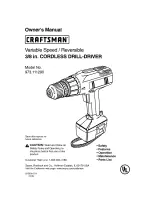
13
12
b.
Do not carry or store battery together with necklaces, hairpins
or other metal objects.
c.
Do not pierce the battery with nails, strike the battery with a
hammer, step on the battery or otherwise subject it to strong
impacts or shocks.
d.
Do not solder directly onto the battery.
e.
Do not expose battery to water or salt water, or allow the
battery to get wet.
f.
Do not disassemble or modify the battery.
g.
Do not place the battery in or near fire, on stoves or other
high temperature locations. Do not place the battery in direct
sunlight, or use or store the battery inside cars in hot weather.
h.
Do not place the battery in microwave ovens, high-pressure
containers or on induction cookware.
i.
If you intend to store a battery for a period without use then
store battery at room temperature (19°C to 25°C), charged
to about 30 – 50% of capacity. When storing for very long
periods boost charge the battery once per year to prevent over
discharge.
The following information applies to professional users only but is
good practice for all users:
ADDITIONAL SAFETY WARNING FOR CONSTRUCTION DUST
The updated Control of Substances Hazardous to Health
Regulations 1st October 2012 now also targets to reduce the
risks associated with silica, wood and gypsum dusts. Construction
workers are one of the at-risk groups within this because of the
dust that they breathe: silica dust is not just a nuisance; it is a real
risk to your lungs!
Silica is a natural mineral present in large amounts in things like
sand, sandstone and granite. It is also commonly found in many
construction materials such as concrete and mortar. The silica is
broken into very fine dust (also known as Respirable Crystalline
Silica or RCS) during many common tasks such as cutting, drilling
and grinding. Breathing in very fine particles of crystalline silica
can lead to the development of: Lung cancer Silicosis Chronic
Obstructive Pulmonary Disorder/Chronic obstructive pulmonary
disease (COPD) And breathing in fine particles of wood dust can
lead to the development of Asthma. The risk of lung disease is
linked to people who regularly breathe construction dust over a
period of time, not on the odd occasion.
To protect the lung, the COSHH Regulations sets a limit on the
amount of these dusts that you can breathe (called a Workplace
Exposure Limit or WEL) when averaged over a normal working
day. These limits are not a large amount of dust: when compared
to a penny it is tiny – like a small pinch of salt: This limit is the legal
maximum; the most you can breathe after the right controls have
been used.
HOW TO REDUCE THE AMOUNT OF DUST?
1. Reduce the amount of cutting by using the best sizes of building
products. Use a less powerful tool e.g. a block cutter instead of
angle grinder.
2. Using a different method of work altogether – e.g. using a nail
gun to direct fasten cable trays instead of drilling holes first.
3. Please always work with approved safety equipment, such
as those dust masks that specially designed to filter out
microscopic particles and use the dust extraction facility at all
time.
For more information please see the HSE website: http://www.hse.
gov.uk/construction or http://www.hse.gov.uk/pubns/cis69.pdf



































